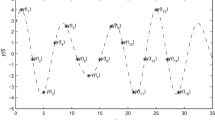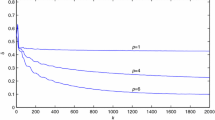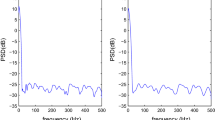Abstract
This paper studies the problem of parameter estimation for frequency response signals. For a linear system, the frequency response is a sine signal with the same frequency as the input sine signal. When a multi-frequency sine signal is applied to a system, the system response also is a multi-frequency sine signal. The signal modeling for multi-frequency sine signals is very difficult due to the highly nonlinear relations between the characteristic parameters and the model output. In order to obtain the parameter estimates of the multi-frequency sine signal, the signal modeling methods based on statistical identification are proposed by means of the dynamical window discrete measured data. By constructing a criterion function with respect to the model parameters to be estimated, a hierarchical multi-innovation stochastic gradient estimation method is derived through parameter decomposition. Moreover, the forgetting factor and the convergence factor are introduced to improve the performance of the algorithm. The simulation results show the effectiveness of the proposed methods.
Similar content being viewed by others
References
Z. B. Yu, Y. K. Sun, and W. D. Jin, “A novel generalized demodulation approach for multi-component signals,” Signal Processing, vol. 118, pp. 188–202, January 2016.
L. Xu, “The damping iterative parameter identification method for dynamical systems based on the sine signal measurement,” Signal Processing, vol. 120, pp. 660–667, March 2016.
Z. Liu, T. Y. Chai, W. Yu, and J. Tang, “Multi-frequency signal modeling using empirical mode decomposition and PCA with application to mill load estimation,” Neurocomputing, vol. 169, pp. 392–402, December 2015.
X. L. Li and F. Ding, “Signal modeling using the gradient search,” Applied Mathematics Letters, vol. 26, no. 8, pp. 807–813, August 2013.
D. Belega and D. Petri, “Sine-wave parameter estimation by interpolated DFT method based on new cosine windows with high interference rejection capability,” Digital Signal Processing, vol. 33, pp. 60–70, October 2014.
L. Xu, L. Chen, and W.L. Xiong, “Parameter estimation and controller design for dynamic systems from the step responses based on the Newton iteration,” Nonlinear Dynamics, vol. 79, no. 3, pp. 2155–2163, February 2015.
L. Xu, “Application of the Newton iteration algorithm to the parameter estimation for dynamical systems,” Journal of Computational and Applied Mathematics, vol. 288, pp. 33–43, Novenber 2015.
F. Ding, F. F. Wang, L. Xu, T. Hayat, and A. Alsaedi, “Parameter estimation for pseudo-linear systems using the auxiliary model and the decomposition technique,” IET Control Theory and Applications, vol. 11, no. 3, pp. 390–400, February 2017.
X. Zhang, F. Ding, F. Alsaadi, and T. Hayat, “Recursive parameter identification of the dynamical models for bilinear state space systems,” Nonlinear Dynamics, vol. 89, no. 4, pp. 2415–2429, September 2017.
L. Xu and F. Ding, “Recursive least squares and multiinnovation stochastic gradient parameter estimation methods for signal modeling,” Circuits, Systems and Signal Processing, vol. 36, no. 4, pp. 1735–1753, April 2017.
F. Ding, Y. J. Wang, J. Y. Dai, Q. S. Li, and Q. J. Chen, “A recursive least squares parameter estimation algorithm for output nonlinear autoregressive systems using the inputoutput data filtering,” Journal of the Franklin Institute, vol. 354, no. 15, pp. 6938–6955, October 2017.
F. Ding, “State filtering and parameter estimation for state space systems with scarce measurements,” Signal Processing, vol. 104, pp. 369–380, November 2014.
F. Ding, G. Liu, and X. P. Liu, “Parameter estimation with scarce measurements,” Automatica, vol. 47, no. 8, pp. 1646–1655, August 2011.
J. Bian, J. Xing, J. Liu, Z. Li, and H. Li, “An adaptive and computationally efficient algorithm for parameters estimation of superimposed exponential signals with observations missing randomly,” Digital Signal Processing, vol. 48, pp. 148–162, January 2016.
D. Q. Wang. Z. Zhang, and J. Y. Yuan, “Maximum likelihood estimation method for dual-rate Hammerstein systems,” International Journal of Control, Automation, and Systems, vol. 15, no. 2 pp. 698–705, April 2017.
J. Pan, X. Jiang, X. K. Wan, and W. Ding, “A filtering based multi-innovation extended stochastic gradient algorithm for multivariable control systems,” International Journal of Control Automation and Systems, vol. 15, no. 3, pp. 1189–1197, January 2017.
L. Xu and F. Ding, “The parameter estimation algorithms for dynamical response signals based on the multiinnovation theory and the hierarchical principle,” IET Signal Processing, vol. 11, no. 2, pp. 228–237, April 2017.
F. Ding, F. F. Wang, L. Xu, and M. H. Wu, “Decomposition based least squares iterative identification algorithm for multivariate pseudo-linear ARMA systems using the data filtering,” Journal of the Franklin Institute, vol. 354, no. 3, pp. 1321–1339, February 2017.
M. H. Li, X. M. Liu, and F. Ding, “The maximum likelihood least squares based iterative estimation algorithm for bilinear systems with autoregressive moving average noise,” Journal of the Franklin Institute, vol. 354, no. 12, pp. 4861–4881, August 2017.
M. H. Li, X. M. Liu, and F. Ding, “The gradient based iterative estimation algorithms for bilinear systems with autoregressive noise,” Circuits, Systems and Signal Processing, vol. 36, no. 11, pp. 4541–4568, November 2017.
D. Q. Wang, L. Mao, and F. Ding, “Recasted models based hierarchical extended stochastic gradient method for MIMO nonlinear systems,” IET Control Theory and Applications, vol. 11, no. 4, 476–485, February 2017.
M. T. Chen, F. Ding, L. Xu, T. Hayat, and A. Alsaedi, “Iterative identification algorithms for bilinear-in-parameter systems with autoregressive moving average noise,” Journal of the Franklin Institute, vol. 354, no. 17, pp. 7885–7898, November 2017.
F. Ding, L. Xu, F. E. Alsaadi, and T. Hayat, “Iterative parameter identification for pseudo-linear systems with ARMA noise using the filtering technique,” IET Control Theory and Applications, vol. 12, no. 7, pp. 892–899, May 2018.
F. Ding, L. Xu, and Q. M. Zhu, “Performance analysis of the generalised projection identification for time-varying systems,” IET Control Theory and Applications, vol. 10, no. 18, pp. 2506–2514, December 2016.
L. Xu, and F. Ding, “Parameter estimation for control systems based on impulse responses,” International Journal of Control, Automation, and Systems, vol. 15, no. 6, pp. 2471–2479, December 2017.
L. Xu, “The parameter estimation algorithms based on the dynamical response measurement data,” Advances in Mechanical Engineering, vol. 9, no. 11, 1–12, November 2017.
F. Ding and X. H. Wang, “Hierarchical stochastic gradient algorithm and its performance analysis for a class of bilinear-in-parameter systems,” Circuits, Systems and Signal Processing, vol. 36, no. 4, pp. 1393–1405, April 2017.
J. Chen and B. Jiang, “Modified stochastic gradient parameter estimation algorithms for a nonlinear two-variable difference system,” International Journal of Control, Automation and Systems, vol. 14, no. 6, pp. 1493–1500, December 2016.
Y. Pan and H. Y. Yu, “Composite learning from adaptive dynamic surface control,” IEEE Transactions on Automatic Control, vol. 61, no. 9, pp. 2603–2609, September 2016.
S. Zhao, F. Wang, H. Xu, and J. Zhu, “Multi-frequency identification method in signal processing,” Digital Signal Processing, vol. 19, no. 4, pp. 555–566, July 2009.
M. H. Li, X. M. Liu, and F. Ding, “Least-squares-based iterative and gradient-based iterative estimation algorithms for bilinear systems,” Nonlinear Dynamics, vol. 89, no. 1, pp. 197–211, July, 2017.
L. Xu, F. Ding, Y. Gu, A. Alsaedi, and T. Hayat, “A multiinnovation state and parameter estimation algorithm for a state space system with d-step state-delay,” Signal Processing, vol. 140, pp. 97–103, November 2017.
L. Xu, F. Ding, “Iterative parameter estimation for signal models based on measured data,” Circuits, Systems and Signal Processing, no. 7, pp. 3046–3069, July 2018.
J. L. Ding, “Recursive and iterative least squares parameter estimation algorithms for multiple-input-output-error systems with autoregressive noise,” Circuits, Systems and Signal Processing, no. 5, pp. 1884–1906, May 2018.
N. Zhao, M. H. Wu and J. J. Chen, “Android-based mobile educational platform for speech signal processing,” International Journal of Electrical Engineering Education, vol. 54, no. 1, pp. 3–16, January 2017.
Y. Lin and W. Zhang, “Necessary/sufficient conditions for pareto optimum in cooperative difference game,” Optimal Control, Applications and Methods, vol. 90, pp. 286–293, April 2018.
F. Liu, Q. Y. Xue, and K. Yabuta, “Rough maximal singular integral and maximal operators supported by subvarieties on Triebel-Lizorkin spaces,” Nonlinear Analysis, vol. 171, pp. 41–72, June 2018.
X. F. Li, Y. D. Chu, and Y. T. Andrew, “Synchronization of uncertain chaotic systems via complete-adaptive-impulsive controls,” Chaos Solitons & Fractals, vol. 100, pp. 24–30, July 2017.
W. Zhang, X. Lin, and B.S. Chen, “LaSalle-type theorem and its applications to infinite horizon optimal control of discrete-time nonlinear stochastic systems,” IEEE Transactions on Automatic Control, vol. 62, no. 1, pp. 250–261, January 2017.
Y. Wang, D. Zhao, Y. Li, and S. X. Ding, “Unbiased minimum variance fault and state estimation for linear discrete time-varying two-dimensional systems,” IEEE Transactions on Automatic Control, vol. 62, no. 10, 5463–5469, October 2017.
Y. Wang, H. Zhang, S. Wei, D. Zhou, and B. Huang, “Control performance assessment for ILC-controlled batch processes in two-dimensional system framework,” IEEE Transactions on Systems, Man and Cybernetics: Systems, 2018.
F. Liu, “Continuity and approximate differentiability of multisublinear fractional maximal functions,” Mathematical Inequalities & Applications, vol. 21, no. 1, pp. 25–40, January 2018.
N. Zhao, Y. Chen, R. Liu, M. H. Wu, and W. Xiong, “Monitoring strategy for relay incentive mechanism in cooperative communication networks,” Computers & Electrical Engineering, vol. 60, pp. 14–29, January 2017.
Y. Ji and F. Ding, “Multiperiodicity and exponential attractivity of neural networks with mixed delays,” Circuits, Systems and Signal Processing, vol.36, no. 6, pp. 2558–2573, Jun, 2017.
F. Ding, H. B. Chen, L. Xu, J. Y. Dai, Q. S. Li, and T. Hayat, “A hierarchical least squares identification algorithm for Hammerstein nonlinear systems using the key term separation,” Journal of the Franklin Institute, vol. 355, no. 8, pp. 3737–3752, May 2018.
M. H. Li and X. M. Liu, “The least squares based iterative algorithms for parameter estimation of a bilinear system with autoregressive noise using the data filtering technique,” Signal Processing, vo. 147, pp. 23–34, June 2018.
P. Ma, F. Ding, and Q. M. Zhu, “Decomposition-based recursive least squares identification methods for multivariate pseudolinear systems using the multi-innovation,” International Journal of Systems Science, vol. 49, no. 5, pp. 920–928, April 2018.
X. Zhang, L. Xu, F. Ding, and T. Hayat, “Combined state and parameter estimation for a bilinear state space system with moving average noise,” Journal of the Franklin Institute, vol. 355, no. 6, pp. 3079–3103, April 2018.
F. Liu, “Endpoint regularity of discrete multisublinear fractional maximal operators associated with l(1)-balls,” Journal of Inequalities and Applications, Article Number: 33, Februry 2018.
Author information
Authors and Affiliations
Corresponding author
Additional information
Recommended by Associate Editor Yongping Pan under the direction of Editor Duk-Sun Shim. This work was supported by the Science Research of Colleges Universities in Jiangsu Province (No. 16KJB120007, China), and sponsored by Qing Lan Project, and the National Natural Science Foundation of China (No. 61773182), and sponsored by Postdoctoral Science Foundation of Jiangsu Province (No. 1701020A), the 111 Project (B12018), and the Natural Science Foundation of Jiangsu Province (No. BK20160162 and No. BK20140164). The first author is grateful to Professor Feng Ding at the Jiangnan University for his helpful suggestions and the main idea of this work comes from him and the series papers in the Journal of Qingdao University of Science and Technology, 2017.
Ling Xu was born in Tianjin, China. She received the Master and Ph.D. degrees from the Jiangnan University (Wuxi, China) in 2005 and 2015. She has been an Associate Professor since 2015. She is a Colleges and Universities “Blue Project” Young Teacher (Jiangsu). Her research interests include process control, parameter estimation and signal modeling.
Weili Xiong received her Ph.D. degree in School of Communication and Control Engineering from Jiangnan University (Wuxi, China) in 2007. She has been a professor in the School of Internet of Things Engineering at the Jiangnan University. She was a visiting scholar in Department of Chemical and Materials Engineering, University of Alberta, Edmonton, Canada from 2013 to 2014. Her research interests include system identification, soft sensor of industry processes and optimization.
Ahmed Alsaedi obtained his Ph.D. degree from Swansea University (UK) in 2002. He has a broad experience of research in applied mathematics. His fields of interest include dynamical systems, nonlinear analysis involving ordinary differential equations, fractional differential equations, boundary value problems, mathematical modeling, Newtonian and Non-Newtonian fluid mechanics. He served as the chairman of the mathematics department at KAU and presently he is serving as director of the research program at KAU.
Tasawar Hayat was born in Khanewal, Punjab, Distinguished National Professor and Chairperson of Mathematics Department at Quaid-I-Azam University is renowned worldwide for his seminal, diversified and fundamental contributions in models relevant to physiological systems, control engineering. He has a honor of being fellow of Pakistan Academy of Sciences, Third World Academy of Sciences (TWAS) and Islamic World Academy of Sciences in the mathematical Sciences.
Rights and permissions
About this article
Cite this article
Xu, L., Xiong, W., Alsaedi, A. et al. Hierarchical Parameter Estimation for the Frequency Response Based on the Dynamical Window Data. Int. J. Control Autom. Syst. 16, 1756–1764 (2018). https://doi.org/10.1007/s12555-017-0482-7
Received:
Revised:
Accepted:
Published:
Issue Date:
DOI: https://doi.org/10.1007/s12555-017-0482-7




